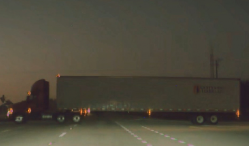
— A Tesla Model 3 crash that killed driver Jeremy Banner was caused by a combination of factors, including Banner's overreliance on Tesla's Autopilot system.
The March 2019 crash occurred when Banner, 50, was driving his 2018 Model 3 on Highway 441 in Delray Beach, Florida.
According to the National Transportation Safety Board (NTSB), Mr. Banner was killed when his Tesla slammed into a tractor-trailer trying to cross the southbound lanes of Highway 441 to turn left into the northbound lanes.
The 45-year-old truck driver says he slowed the truck before beginning to cross the highway, seeing the Model 3 coming his way but believing he had enough time to cross the highway. (Photo above shows the tractor-trailer crossing the highway 1 second before impact)
Banner's Model 3 was traveling 69 mph when it hit the left side of the trailer, shearing off the roof of the car as it traveled under the trailer before continuing southbound and coming to a stop about 1,680 feet from where the car hit the trailer.
Mr. Banner engaged Traffic-Aware Cruise Control at a cruise speed of 69 mph 12.3 seconds before impact, then activated Autosteer 2.4 seconds later which activated Autopilot. Based on data from the car, the system did not detect any steering wheel torque for the final 7.7 seconds before impact.
The report says the Model 3 forward collision warning and automatic emergency braking systems failed to activate and there was no evidence Banner took any action to avoid the crash.
Tesla told NHTSA the Model 3 Autopilot system wasn't designed for situations such as the one that killed Banner and the forward collision warning and automatic emergency braking systems weren't designed to activate for crossing traffic.
The systems also weren't designed to prevent high-speed crashes, leaving Autopilot unable to recognize the tractor-trailer as a threat or an object.
The government says the probable cause of the crash was the truck driver who failed to yield to the oncoming Model 3, combined with Banner ignoring the road due to an overreliance on Autopilot and technology.
The NTSB also found the design of Autopilot contributed to the crash due to Tesla's failure to block the activation of the system in conditions Autopilot was never meant to be used. Additionally, the NTSB says the Autopilot system permitted Banner to ignore the road and his surroundings.
Also named as a contributor to the crash is the National Highway Traffic Safety Administration (NHTSA) and its failures to mandate safety regulations for systems related to partial automation.
NTSB investigators say the Delray Beach crash is the third fatal crash that involved a driver who relied too much on Tesla's Autopilot system.
The NTSB report mimics another Tesla crash report in Florida where Autopilot failed to recognize a tractor-trailer crossing a highway.
As with the Model 3 crash, the 2016 crash of a Tesla Model S involved a driver who placed his faith in unproven technology. And just as the Model 3 driver lost his life when the car traveled under the trailer, the Tesla Model S driver lost his life in the exact same way.




